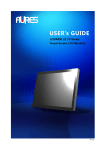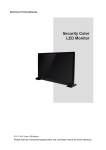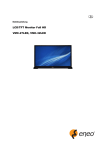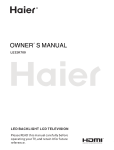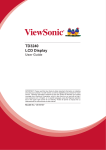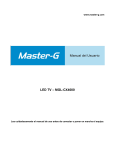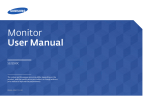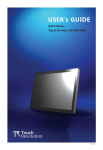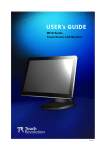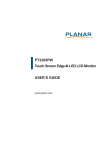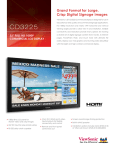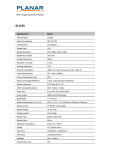Download USER's GUIDE - Support Technique AURES
Transcript
USER’s GUIDE LCDWIDE 32’’ FP Series Touch Screen LCD Monitors Rev.B The information contained in this document is subject to change without notice. This document contains proprietary information that is protected by copyright. All rights are reserved. No part of this document may be reproduced,translated to another language or stored in a retrieval system, or transmitted by any means, electronic, mechanical, photocopying, recording, or otherwise, without prior written permission. Windows is a registered trademark of Microsoft, Inc. Other brand or product names are trademarks of their respective holders. The test results show that this device meets the FCC rules. Those limits are set to protect residential areas from the devices with harmful emission. This device will produce, use and radiate radio frequency energy. In addition, failure to follow the user’s manual to install or use this device might produce harmful interference with radio communication. Not withstanding the foregoing, it does not guarantee that this type of harmful interference does not occur in some special installations. The interference caused by this device to the reception of radio or television signals may be verified by turning it on and off. Any changes or modifications to this TFT LCD would void the user’s authority to operate this device. Table of Contents Usage Notice Precautions............................................................................................................................. 1 Introduction About LCDWIDE 32’’ FP Series.............................................................................................. 2 Touch Screen for LCDWIDE 32’’ FP ....................................................................................... 3 Package Overview ....................................................................................................... 4 Installation Product Overview......................................................................................................... 5 Front View ............................................................................................................... 5 Bottom View ............................................................................................................ 5 VESA Mount for Your Monitor....................................................................................... 6 Customer Panel Material.............................................................................................. 7 Sealing foam installation............................................................................................... 8 Start Your Installation................................................................................................... 9 Connecting the Display (Figure 10.1)...........................................................................10 (Figure 10.1)............................................................................................................11 User Controls Rear Panel Controls....................................................................................................12 How to Use the OSD Menus........................................................................................13 On-Screen Display Menus...........................................................................................14 Appendix Troubleshooting...........................................................................................................15 Warning Signal............................................................................................................16 No Signal ...............................................................................................................16 Going to Sleep........................................................................................................16 Out of Range...........................................................................................................16 Product Dimensions....................................................................................................17 Compatibility Modes....................................................................................................18 Touch Screen Driver Installation..................................................................................19 Optional Calibration Tool Install....................................................................................... 20 Driver Install Instructions ............................................................................................22 Usage Notice ! ! Warning - To prevent the risk of fire or shock hazards, do not expose this product to rain or moisture. Warning - Please do not open or disassemble the product as this may cause electric shock. Precautions Follow all warnings, precautions and maintenance as recommended in this user’s manual to maximize the life of your unit. Do: • Turn off the product before cleaning. • Touch screen surface may be cleaned using a soft clean cloth moistened with mild window glass commercial cleaners or 50/50 mixture of water and isopropylalcohol. • Use a soft cloth moistened with mild detergent to clean the display housing. • Disconnect the power plug from AC outlet if the product is not going to be used for an extended period of time. Don’t: • Do not touch the LCD display screen surface with sharp or hard objects. • Do not use abrasive cleaners, waxes or solvents for your cleaning. • Do not operate the product under the following conditions: - Extremely hot, cold or humid environment. - Areas susceptible to excessive dust and dirt. - Near any appliance generating a strong magnetic field. - In direct sunlight. 1 Introduction About LCDWIDE 32’’ FP Series The LCDWIDE 32’’ FP Series is a 31.5" flat panel screen with an active matrix, thin-film transistor (TFT) liquid crystal display (LCD). Features include: • Direct Analog signal input • Direct Digital signal input • Active matrix TFT LCD technology • 1920 x 1080 resolution • 31.5" viewable display area - 16:9 aspect ratio • 31.47 ~ 67.5 KHz horizontal scan • 47 ~ 63 Hz high refresh rate • 0.36375mm x 0.36375mm pixel pitch • Auto adjustment function • Multilingual OSD user control • 400mm x 200mm VESA mount • Projected Capactive touch screen with USB controller • Audio - 8W x 2 2 Touch Screen for LCDWIDE 32’’ FP • Project Capacitive touch screen for finger input only • Surface: Glare treatment • Interface: USB controller • Transmittance: 90%±5% • HID: Windows® 7/8 • Driver: Windows® 7/8, VISTA, XP, 2000, CE, XP Embedded, Linux kernel 2.6.X(32 bit & 64 bit), Apple® Mac OS. 3 Package Overview LCD Display Power Cord VGA Signal Cable USB Cable (A to B) Audio-in Cable DVI-D Cable Remote Key (sold separately) Touch Driver CD Cable Cover Screw 4 Installation Product Overview • Front View • Bottom View USB COM OUT COM IN REMOTE KEY AUDIO OUT AC IN DVI IN VGA IN AUDIO IN 5 VESA Mount for Your Monitor This monitor conforms to the VESA Flat Panel Mounting Physical Mounting Interface standard which defines a physical mounting interface for flat panel monitors, and corresponding with the standards of flat panel monitor mounting devices, such as wall and table arms. The VESA mounting interface is located on the back of your monitor. To mount the monitor on a UL certified swing arm or other mounting fixture, follow the instructions included with the mounting fixture to be used. Front Mount W/ VESA Mount 400x200 screw holes Use the M6-MECH. screw types (Depth 14.0 mm) 400 mm 190.77 mm 134.31 mm 167.87 mm 140 mm 200 mm 16.67 mm 168.07 mm 140 mm 16.67 mm 748.2 mm Rear Mount W/ 2 Sides Handle Screw holes Use the M5-MECH. screw types (Depth 12.0 mm) ! Warning! Please select the proper screws! The distance between the back cover surface and the bottom of the screw hole is 8 mm. Please use four M6 screws diameter with proper length to mount your monitor. Please note: the mounting stand must be able to support at least 44.1 lbs (20Kg). 6 Customer panel material: 1. Wooden wall: Ø6.0mm thru holes for M5 screws w/nuts(For Front mount /use VESA 400x200, M6 screw types.), Ø7.0mm thru holes for M6 screws w/nuts(For Rear mount / use 2 sides Handles-M5 screw types.) 2. Sheet metal: Concealed head threaded studs M6 W/Nuts (For Front mount /use VESA 400x200, M6 screw types.) Concealed head threaded studs M5 W/Nuts (For Rear mount /use 2 sides Handles-M5 screws types.) Recommended Customer Panel cut-Out (Front mount recommend size: offset Monitor size 2.0mm) 785.54 mm +1.0 0 4-R12.65 480.14 mm +1.0 0 Recommended Customer Panel cut-Out (Rear mount recommend size: offset Monitor size 1.5mm) +1.0 784.54 mm 0 4-R12.15 479.14 mm +1.0 0 IMPORTANT! The wall mounting instructions are for the qualified wall mounting person only! ! Warning! Please select the proper screws! The distance between the back cover surface and the bottom of the screw hole is 8 mm. Please use four M6 screws diameter with proper length to mount your monitor. Please note: the mounting stand must be able to support at least 44.1 lbs (20Kg). 7 Sealing foam installation Sealing / Rear Mounting Sealing foam narrow side facing the glass surface (top) SEE DETAIL A DETAIL A SCALE 4.000 Sealing / Front Mounting Sealing foam wide side facing the glass surface (top) SEE DETAIL B DETAIL B SCALE 4.000 8 Start Your Installation Please follow these instructions so that you can hook up the cables to associated connectors. 1. Lay the LCD flat on an even surface and take off cable cover as seen in the step 1 diagram. 2. Connect the cables to the appropriate connectors as seen in the step 2 diagram. 3. Take screw from the accessory box, and put all cables under the cover lip, then use a Philips Head screw driver, insert the screw (CBM M3x6) into cable cover and monitor as seen in the step 3-1 or step 3-2 diagram either. Step 1 Step 2 Power DVI VGA Audio-In Step 3-1 USB COM-Out COM-In Audio-Out Step 3-2 9 Connecting the Display (Figure 10.1) To setup this display, please refer to the following figure and procedures. 1. Be sure all equipment is turned off. 2. Connect the AC power cord to the power connector on the monitor and the other end into an electrical outlet (10.1). 3. Connect the D-SUB or DVI cable from the display’s VGA input connector to the D-SUB or DVI connector of your host computer and tighten the screws (10.1). 4. Connect the Audio-In cable from the audio input port of your display to the Audio-out port of your computer (10.1). 5. Connect the USB cable from USB port of your display to USB port of your computer (10.1). 6. Once the touch screen is configured, the monitor is ready for use. ! Notice! To ensure the LCD display works well with your computer, please configure the display mode of your graphics card to make it less than or equal to 1920 x 1080 resolution and make sure the timing of the display mode is compatible with the LCD display. We have listed the compatible “Video Modes” of your LCD display in the appendix (on page 18) for your reference. 10 (Figure 10.1) 11 User Controls Rear Panel Controls Icon Key Name Menu Up Down Select Power OSD Key Menu off status Menu on status Menu appear Menu disappear / return to main item Brightness Main item select up / Adjust up Mute Main item select down / Adjust down Auto Adjust Select sub-item function Power On / Off 12 How to Use the OSD Menus Icon Key Name Menu Up Down Select Power 1. Press the “MENU” button to pop up the “on-screen menu” and press “Up” or “Down” button to select among the six functions in the main menu. 2. Choose the adjustment items by pressing the “Select” button. 3. Adjust the value of the adjustment items by pressing the “Up” or “Down” button. 4. With the OSD menu on screen, press “ Menu” button to return main menu or exit OSD. 5. The OSD menu will automatically close, if you have left it idle for a pre-set time. 6. To Lock the OSD / Power menu buttons, please follow the instructions below. (Please note: the monitor has to be turned ON with a valid signal pre-set) (a.) Press “Menu” key , the OSD menu pops upon display. (b.) Press and hold the “Menu” key again with the OSD menu on the screen, the OSD menu will disappear. Then press the “Power” key 1 time while the menu key is still being pressed. The “Lock/Unlock” menu will appear for 3 seconds. (c.) Use the “Select” key to select OSD or Power setting then set at “Lock” by pushing the “UP” or “Down” button. (d.) When the “UP” or “Down” button is released, the previous setting will be saved and exit the “Lock/Unlock” menu automatically. 7. To Unlock the OSD / Power menu buttons, please follow the instructions below. (Please note: the monitor has to be turned ON with a valid signal pre-set) (a.) Press and hold the “Menu” key then press the “Power” key simultaneously, the “Lock/ Unlock” menu will appear for 3 seconds. (b.) Use the “Select” key to select OSD or Power setting then set at “Unlock” by pushing the “UP” or “Down” button. (c.) When the “UP” or “Down” button is released, the previous setting will be saved and exit the “Lock/Unlock” menu automatically. Please note: a. When the OSD Lock function is selected, this indicates that all the buttons except “power” button are now disabled. b. When the Power Lock function is selected, this indicates that the power key is disabled; user can not to turn off the monitor by “Power” key. 13 On-Screen Display Menus Main OSD Menu: ITEM CONTENT Contrast The monitor luminance level control. Brightness The monitor backlight level control. Auto Adjust Fine-tune the image to full screen automatically. Left/Right Moving screen image horizontal position to left or right. Up/Down Moving screen image vertical position to up or down. Horizontal size The screen image horizontal dot clock adjustment. Fine The screen image pixel phase adjustment. OSD Left/Right Moving OSD menu horizontal position to left or right. OSD Up/Down Moving OSD menu vertical position to up or down. OSD Time out OSD auto-disappear time selection. OSD Language OSD menu language selection. ( English, French, Japanese, Deutsch, Spanish, Italian, Traditional Chinese and Simplified Chinese) Factory Reset Factory default value restored. RGB Color temperature selection. (9300K, 6500K, 5500K, 7500K, User) Volume Audio volume adjustment. Mute Audio On/Off control. FAN FAN On/Off control. Note: When table mount used, please turn on FAN power by OSD. 14 Appendix Troubleshooting If you are experiencing trouble with the LCD display, refer to the following. If the problem persists, please contact your local dealer or our service center. Problem: No image appears on screen. ► Check that all the I/O and power connectors are correctly and well connected as described in the “Installation” section. ► Make sure the pins of the connectors are not crooked or broken. Problem: Partial Image or incorrectly displayed image. ► Check to see if the resolution of your computer is higher than that of the LCD display. ► Reconfigure the resolution of your computer to make it less than or equal to 1920 x 1080. Problem: Image has vertical flickering line bars. ► Use “Fine” to make an adjustment. ► Check and reconfigure the display mode of the vertical refresh rate of your graphic card to make it compatible with the LCD display. Problem: Image is unstable and flickering ► Use “Fine” to make an adjustment. Problem: Image is scrolling ► Check and make sure the VGA signal cable (or adapter) is securely connected. ► Check and reconfigure the display mode of the vertical refresh rate of your graphics card to make it compatible with the LCD display. Problem: Vague image (characters and graphics) ► Use “Fine” to make an adjustment. If this problem still exists, use “Horizontal size” to make an adjustment. 15 Warning Signal If you see warning messages on your LCD screen, this means that the LCD display cannot receive a clean signal from the computer graphics card. Below are the three kinds of Warning Signal. Please check the cable connections or contact your local dealer or our service center for more information. No Signal This message means that the LCD display has been powered on but it cannot receive any signal from the computer graphics card. Check all the power switches, power cables, and VGA/DVI signal cable. Going to Sleep The LCD display is under the power saving mode. In addition, the LCD display will enter power saving mode when experiencing a sudden signal disconnecting problem. The monitor can be activated by pressing any keyboard, triggering the mouse or touching the screen. Out of Range This message means that the signal of the computer graphic card is not compatible with the LCD display. When the signal is not included in the “Video Modes” list we have listed in the Appendices of this manual, the LCD monitor will display this message. 16 Product Dimensions 69.7 393.3±0.5 +1.0 0 44.7 1.8 280.2 92.1 698.7±0.5 Front View 781.54 Side View +1.0 0 590 400 200 352.93 Back View 17 476.14 +1.0 0 Compatibility Modes Mode Resolution H-Frequency(khz) V-Frequency(hz) IBM VGA 640X480 31.47 60 VESA SVGA 800X600 35.16 56 VESA SVGA 800X600 37.88 60 VESA XGA 1024X768 48.36 60 VESA SXGA 1280X1024 64.00 60 VESA SXGA 1280X960 60.00 60 WXGA+ 1440X900 56.00 60 WSXGA+ 1680X1050 65.20 60 VESA WXGA 1280X768 47.776 60 VESA WXGA 1280X720 44.77 60 VESA WXGA 1366X768 47.71 60 WSXGA+ 1920X1080 67.50 60 18 Touch Screen Driver Installation The LCDWIDE 32’’ FP is available with USB connections. The touch driver is located on the enclosed CD-ROM for these operating systems: Windows® 7/8, VISTA, XP, 2000, CE, XP Embedded, Linux Kernel 2.6.x (32 bit & 64 bit), Apple® Mac OS. (Windows 7/8 Multi touch without driver) Please Note: 1. The LCDWIDE 32’’ FP is Microsoft® Windows® HID (Human Interface Device) compatible if you use the USB touch screen interface. No additional software driver is required for general operation of the touch screen. A calibration tool can be installed for improved touch position accuracy. See “Optional Calibration Tool Install” section for more information. 2. For LCDWIDE 32’’ FP, the system requires 15 seconds for Windows 7/8 to install/uninstall the touch drivers while turning power on/off or plugging/unplugging USB cable. 19 Optional Calibration Tool Install: Calibrating the touch screen in Windows 7/8: 1. Tap the Start button, Control Panel and then Hardware and Sound. 2. Under Tablet PC Settings, tap Calibrate the screen for pen or touch input. 3. On the Display tab, under Display options, tap Calibrate and then Yes to allow the program to make changes. 4. Follow the on-screen instructions to calibrate the touch screen. 20 21 Driver Install Instructions: If you are using a PC running Windows® 7/8, VISTA, XP, 2000, follow the instructions below: 1. 2. 3. 4. Power on the PC. Be sure the USB cable is connected from the PC to the LCD display. Open the CD-ROM. Follow the step-by-step instructions as shown on the pop-up windows. If you are using a PC running Windows® XP Embedded, follow the instructions below: Express: 1. Power on the computer. 2. Make sure that the USB cable is connected to the computer. 3. Be sure that your EWF is disabled. If your EWF is enabled, please disable the EWF by using the EWF Manager command. 4. Once the EWF is disabled click on the XP driver on the CD-ROM and follow the step-by-step instructions as shown on the pop-up windows. Custom: 1. Power on the computer. 2. Make sure that the USB cable is connected to the computer. 3. Follow the step-by-step instructions found in the folder file on the CD-ROM. If you are using a PC running Windows® CE, follow the instructions below: 1. Power on the computer. 2. Make sure that the USB cable is connected to the computer. 3. Using Platform Builder, build an image file by following the step-by-step instructions found in the folder file on the CD-ROM. If you are using a PC running Linux Kernel 2.6.x (32 bit & 64 bit) or Apple® Mac OS, follow the instructions below: 1. Power on the computer. 2. Make sure that the USB cable is connected to the computer. 3. Follow the step-by-step instructions found in the folder file on the CD-ROM. 22

























